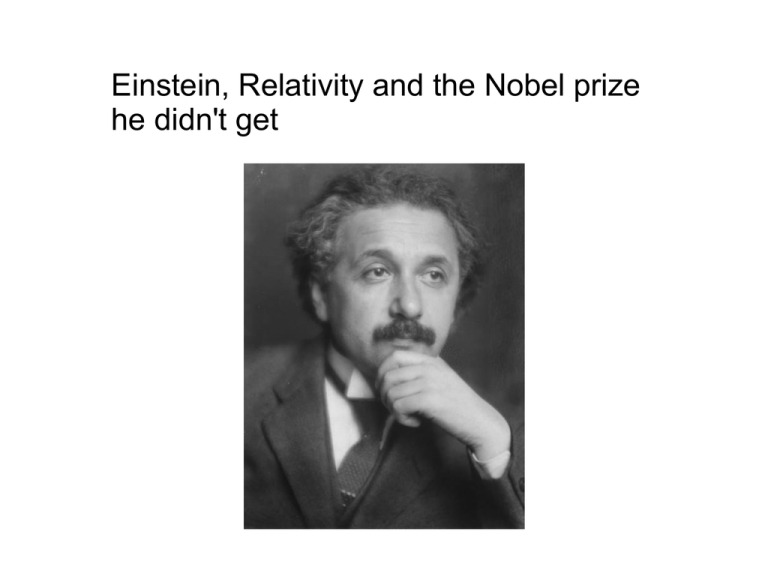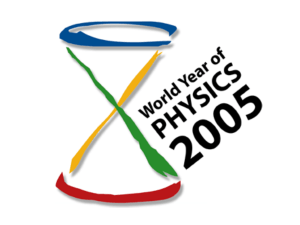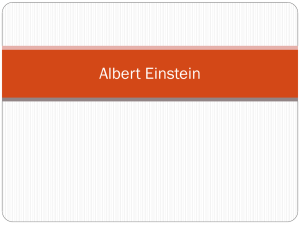Einstein and the Nobel Prize
advertisement

Einstein, Relativity and the Nobel prize he didn't get In 1905 Einstein prodlished 4 papers which were eac worthy of the Nobel prize: Brownian Motion Photoelectric effect Special Relativity E=m c2 Amongst many later achievements one must also mention General Relativity He won the Nobel prize in 1922, when he was awarded the delayed prize for 1921. He did not accept it in person until 1923. Why did it take 17 years to award Einstein a prize when he was regarded as the world's leading theoretical physicist from around 1910 on and he was easily the most famous physicist in the world from 1919 on? Anti-semitism probably played a role Teutonic aversion to his left-wing, pacifist views may also have played a part But probably most central was a dislike of the new breed of theorist of which Einstein was the leading example. Early Laureates by Category (to 1920) Industrial – 1908 Gabriel Lippman for his color photography process 1909 Karl Friedrich Braun and Guglielmo Marconi for wireless 1912 Gustav Dalen for a solar sensitive gas control valve 1920 Charles Edouard Guillaume for the alloys invar and elinvar Experimental Physics – 1901 William Roentgen 1902 Pieter Zeeman (with Lorentz) 1903 Henri Becquerel, Pierre Curie, Marie Curie 1904 Lord Rayleigh 1905 Phillip Lenard (photoelectric effect) 1906 J. J. Thomson 1907 Albert A. Michelson 1913 Heike Kamerlingh Onnes 1914 Max von Laue 1915 William H. Bragg and William L. Bragg 1917 Charles Glover Barkla 1919 Johannes Stark Theoretical Physics – 1902 Abraham Lorentz (with Zeeman) 1910 Johannes van der Waals 1911 Wilhelm Wien 1918 Max Planck The Nobel Process Nominations may be received from previous Laureates (in any field, not just physics), and from professors in select Universities, at this time almost exclusively in Nordic and German speaking countries. Nominations are then considered by a five man committee nominated by the Swedish academy of sciences. In the decade leading up to 1921 Einstein was repeatedly nominated. Two particular members of the committee were chosen to write reports of his suitability for the prize and repeatedly recommended that he not be awarded it. Nobel Prize medal One member of the physics committee who opposed giving the prize to Einstein was the 1903 Chemistry prize winner Svante Arrhenius. Arrhenius was one of the founders of physical chemistry. A physicist himself he explained the electric properties of solutions as being due to ions which were present even without electrolysis. Arrhenius was impressed by Einstein's work on Brownian motion and even thought it was worthy of a Nobel prize. But he argued that since Einstein's other work, which he regarded as still experimentally unproven, dwarfed his achievement with Brownian motion, it would look strange to award the prize only for the latter. Svante Arrhenius, 1859 - 1927 Einstein's most dedicated detractor on the physics committee was Allvar Gullstrand, the winner of the 1911 prize for medicine. Gullstrand's speciality was optics of the eye, hence his prize in medicine. But his interests were in theoretical optics, so relativity wasn't that much of a stretch for him. Indeed, as we shall see, the reasons for his opposition to General Relativity did not lie in his failure to understand the theory, as was true for many critics of the time. Rather they lay in his familiarity with it and his dislike of the theoretical approach it typified. His familiarity with the theory could, had be given the theory more credit, have led to him presciently uncovering an important property of black holes. He remarked to a friend at one point that Einstein “must never receive the Nobel prize, even if the entire World demands it.” Allvar Gullstrand, 1862-1930 Gullstrand's argument Gullstrand, like Arrhenius, argued that there was little empirical evidence in favor of special relativity. General Relativity had its famous three tests, but one of these, the gravitational redshift of the Sun was considered unfavorable to Einstein by most experts until 1922 and another, the bending of light by the Sun was widely contested, in spite of the results of the British 1919 eclipse expedition. The single greatest empirical success of relativity theory, either special or general, was Einstein's explanation of the perihelion advance of Mercury. Einstein had shown that his theory predicted a perihelion shift which, without any adjustable parameter, agreed precisely with the observed effect. Gullstrand sought to show that in fact there was room for different results in the theory by examining the Scharzschild metric which described the spacetime of a single body, such as the Sun. He knew that the same metric could be described by different coordinate systems in Einstein's theory and wondered if different coordinate systems might produce different results for the perihelion advance of Mercury. Choosing the Right metric Einstein's original calculation involved a coordinate choice which Gullstrand claimed helped him fudge the calculation to fit the result. The discovery of the Schwazschild solution cleaned up the calculation considerably. Gullstrand developed a coordinate system radically different from that used by Scharzschild but which could describe exactly the same metric, claiming the perihelion advance was different in this metric and thus, once again, Einstein's theory, by virtue of its own rules could match any result one wished for a given problem. This actually isn't true, but Gullstrand had stumbled upon a very important metric, which is essentially the viewpoint of an observer falling into a black hole. Perihelion advance of Mercury Gullstrand-Painleve coordinates Gullstrand's coordinates are the first which describe the viewpoint of a freely falling observer into a black hole. They do not become singular at the event horizon and clearly show that spacetime is not irregular there. But instead of realizing that he had solved a puzzle in relativity Gullstrand thought he had shown it to be absurd. Yet he had insight enough to realize that a sufficiently compact body would prevent light escaping it, the Dark Star idea. His own coordinates could have shown the Black Hole side of this structure also. Schwarzschild observer Gullstrand observer The man who successfully nominated Einstein for the Nobel prize was Carl Wilhelm Oseen. Oseen adopted the tactic of nominating Einstein for the photoelectric effect. This almost worked in 1921 but Gullstrand successfully prevented any prize from being awarded. In 1922 Oseen joined the Nobel committee himself! He was thus able to steer his own nomination through. One major motivation was to smooth the way for Niels Bohr to simultaneously win the 1922 prize. Theoretical Physics had arrived! Carl Wilhelm Oseen 1879 – 1944 Albert Einstein – Nobel Laureate So in 1920 the committee awarded the prize to the inventor Guillaume, in starkest contrast to the theorist Einstein. In 1921 they did not award the prize at all. In 1922 they finally capitulated and awarded the 1921 prize to him. Einstein reciprocated the Nobel committee's coolness. He did not delay his voyage to Japan in 1922 so that he could receive the prize that year. He came to Sweden a year later in 1923. But he was grateful for the money, which he had already promised in divorce papers to his first wife and family. Einstein receiving the prize




